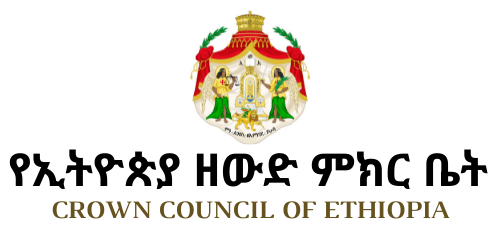It is with deep sorrow that the Crown Council of Ethiopia reports that Her Imperial Majesty Empress Medferiashwork Abele passed away on Friday March 13th, in Addis Ababa, Ethiopia. Her Imperial Majesty was buried at the Holy Trinity Cathedral in Addis Ababa which is the traditional burial place for members of the Imperial Family, patriots, and prominent dignitaries.
Abune Paulos, Patriach of Ethiopia lead the funeral service which took place on Tuesday March 17th. 2009. Hundreds of mourners including members of the Imperial family, the old Ethiopian Nobility, close family friends who flew into Addis Ababa from various parts of the world, prominent members of the Clergy, and the Rastafarian Community, were there to pay their respect.
Her Imperial Majesty who was 84 years old is succeeded by her son Crown Prince Zera Yacob, her three daughters Princess Mariam Sina, Princess Sihin and Princess Sifrash Bizu and their children. It must also be sadly remembered that Emperor Amha Selassie’s eldest daughter HIH Princess Egigayehu who was from his first marriage to HIH Princess Wolette Israel Seyoum, great grand daughter of Emperor Yohannes of Ethiopia, died while in prison under the communist Military Government of the Derge. Therefore, there are also Princess Egigayehu’s six children and seven grandchildren.
Her Imperial Majesty Medferiashwork was born in 1925, in Dessie town of Wollo Province in Northern Ethiopia.
She was the second of three daughters of Major General, Dejazmatch Abebe Damtew by his wife Woizero Wosenyelesh Mengesha. On her father’s side the Empress was the descendant of the prominent Adisge Clan. Her paternal uncle, Ras Desta Damtew was the first husband of Princess Tenagnework Haile-Selassie. Ras Desta, who was a major hero and martyr of the Ethiopian resistance against the Italian occupation, was the father of Princess Aida, Prince Amha (who died at a young age), Princess Hirut, Princess Seble, Princess Sophia, and Commander Iskender Desta. Her Majesty’s maternal grandfather was Ras Bitwoded Mengesha Atikem who was the hereditary Lord of Dermot and Agewmidir, Viceroy of the Kingdom of Gojjam, and thus, a leading nobleman during the reign Of Emperor Menelik II.
As it was the tradition for children of noble families, Her Imperial Majesty began her early education with a private tutor. She then attended the well known Empress Menen School for Girls in Addis Ababa. Soon after the Italian occupation of Ethiopia, Her Majesty accompanied her family to exile in Jerusalem, Israel. While in Jerusalem, her parents and their three daughters lived in close proximity to Empress Menen, consort of Emperor Haile-Selassie who spent a good portion of her exile in the Holy Land. During that period, the young Medferiashwork was enrolled in a boarding school.
After the overthrow of the fascist Italian occupation of Ethiopia in 1941, young Medferiashwork returned to Ethiopia with her family. When Crown Prince Asfawossen and his first wife, Princess Wolette Israel Seyoum divorced in 1941, Medferiashwork Abebe was considered a prime candidate for the position of Crown Princess.
Thus, in April 1945, the young Medferiashwork married Crown Prince Asfawossen and became the Crown Princess of Ethiopia. The Imperial couple had four children namely Crown Prince Zera Yacob, Princess Maryam Sena, Princess Sihin and Princess Sifrash Bizu.
As a Crown Princess, she became one of the most influential and popular members of the Imperial Family. Many admired her courage, tanacity, and her commitment to charity work. Furthermore, the Crown Princess’s devotion in overseeing the bringing up of her children was exemplary. In 1960, during the attempted coup of the Imperial Guards against Emperor Haile-Selassie, when Crown Prince Asfawossen was compelled to announce that he would take over from his father and serve as a Constitutional Monarch, the Crown Princess Medferiashwork who was not placed under detention like some members of the Imperial Family, used the opportunity to host secret meetings of the loyalist leaders that defeated the coup attempt within a few days.
In 1973, when Crown Prince Asfawossen suffered a stroke, the Crown Princess accompanied her husband to Geneva for treatment. Thus, when the Military Government of the Derge abolished the Monarchy in Ethiopia the following year and imprisoned many members of the Imperial Family, Crown Prince Asfawossen and Crown Princess Medferiashwork, and all their children were safely in Geneva, Switzerland. After a few years, the family moved to London, UK to continue their life in exile in more familiar surroundings.
In the years that followed, the Imperial Couple faced a life of great uncertainty in exile and endured the imprisonment and death of His Imperial Majesty Haile Selassie I, and that of other close relatives and friends. During these difficult years, the Empress was a tower of strength and an anchor for her husband and her immediate family. The presence of the Emperor and Empress amongst Ethiopians in exile also served as a great symbol of hope for the rest of the Imperial Family in exile, and the larger Ethiopian community in the Diaspora. At this time, the Imperial Couple was greatly comforted by the sincere friendship of Her Majesty Queen Elizabeth of England, other Royal Families in Europe and around the world, as well as devoted friends of the family of many nationalities.
On April 6th, 1989, when Crown Prince Asfawossen reclaimed the Imperial Crown in Exile under his baptismal name of Amha Selassie I, Her Imperial Majesty Medferiashwork was proclaimed Empress Consort of Ethiopia in Exile. In 1991, the Imperial couple moved from London to the Virginian suburb of Washington DC to be close to the large Ethiopian Community there.
Empress Medferiashwork was widowed in February 1997 when Emperor Amha Selassie I passed away in Virginia after a long illness. Due to the strong historical and personal link of the Imperial Family to their homeland, Her Imperial Majesty Medferiashwork and other members of the Imperial Family ventured to return to Ethiopia for the first time since 1973 to place the remains of His Majesty Amha Selassie amongst those of his ancestors. This great and historic step marked the beginning of the Imperial Family’s return to Ethiopia to live as other citizens in their homeland.
After the passing away of the Emperor, the Empress led a quiet life in Virginia with occasional trips to Ethiopia. During this time, Her Majesty, focused largely on charitable endeavors. Empress Medferiashwork was a major patroness of various Orthodox monasteries and nunneries in Ethiopia. She was particularly devoted to the mountain Monastery of St Mary at Gishen where a fragment of the true cross is venerated.
In November 2000, Empress Medferiashwork attended the re-burial of her father in law Emperor Haile-Selassie, in Addis Ababa, Ethiopia. In March 2005, Her Imperial Majesty together with many members of the Imperial Family attended the funeral of Princess Tenagnework Haile Selassie who had first become her aunt by marriage and later her sister-in-law by marriage. Three years ago, Her Majesty returned to Ethiopia to live there permanently. She passed away on Friday March 13th, 2009 after a relatively short illness.
During her life, Her Imperial Majesty received the three highest Ethiopian Imperial Orders which are Grand Collar and Chain of the Order of Solomon’s seal, the Grand Cordon Order of the Star of Solomon, and the Cordon of the Order of the Queen of Sheba. Her foreign Orders include the Order of the Seraphim of Sweden, Grand Crosses of the Orders of St Olav of Norway, and the Beneficence of Greece.
In closing its tribute to Empress Medferiashwork Abebe, the Crown Council of Ethiopia would like to express its deep gratitude to all those who extended tremendous goodwill and support to their Imperial Majesties and to the rest of the Imperial Family during the many difficult years in exile.
May Her Imperial Majesty Medferiashwork’s soul rest in peace.








